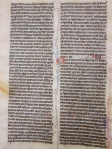 I’ve reached the end of my capstone project and I am happy to say that I have now completed all 49 descriptions for the manuscript collection. I’ll spend a few days next week looking over the work I’ve done with the rare book cataloger and answering any questions he might encounter when he begins using them to create MARC records of the MSS, but basically, I’m finished. I have tried to make sure my descriptions are compatible with the AMREMM (Descriptive Cataloging of Ancient Medieval and Early Modern Manuscripts) so I doubt there will be many issues beyond interpreting the format of my descriptions. I’ll also look over them with the head rare book librarian and answer any questions she might have in regards to using them as data to accompany digital images of the objects in the collection. It may be a few years before all 49 items are digitized and ready to go online, but when they are, my descriptions will accompany them in some form.
I’ve reached the end of my capstone project and I am happy to say that I have now completed all 49 descriptions for the manuscript collection. I’ll spend a few days next week looking over the work I’ve done with the rare book cataloger and answering any questions he might encounter when he begins using them to create MARC records of the MSS, but basically, I’m finished. I have tried to make sure my descriptions are compatible with the AMREMM (Descriptive Cataloging of Ancient Medieval and Early Modern Manuscripts) so I doubt there will be many issues beyond interpreting the format of my descriptions. I’ll also look over them with the head rare book librarian and answer any questions she might have in regards to using them as data to accompany digital images of the objects in the collection. It may be a few years before all 49 items are digitized and ready to go online, but when they are, my descriptions will accompany them in some form.As far as concluding thoughts for this project go, I have mostly good ones, but I was a bit dissapointed that I ended up not doing anything with ContentDM or ARCHON. Having said that, this has been a great opportunity to sharpen my rarebook cataloging skills, particularly with regard to medieval and early modern legal documents and how to interpret and describe them. Hopefully this will open up additional opportunities to continue this type of work as more and more institutions put their medieval manuscript collections online.
good ones, but I was a bit dissapointed that I ended up not doing anything with ContentDM or ARCHON. Having said that, this has been a great opportunity to sharpen my rarebook cataloging skills, particularly with regard to medieval and early modern legal documents and how to interpret and describe them. Hopefully this will open up additional opportunities to continue this type of work as more and more institutions put their medieval manuscript collections online.
 good ones, but I was a bit dissapointed that I ended up not doing anything with ContentDM or ARCHON. Having said that, this has been a great opportunity to sharpen my rarebook cataloging skills, particularly with regard to medieval and early modern legal documents and how to interpret and describe them. Hopefully this will open up additional opportunities to continue this type of work as more and more institutions put their medieval manuscript collections online.
good ones, but I was a bit dissapointed that I ended up not doing anything with ContentDM or ARCHON. Having said that, this has been a great opportunity to sharpen my rarebook cataloging skills, particularly with regard to medieval and early modern legal documents and how to interpret and describe them. Hopefully this will open up additional opportunities to continue this type of work as more and more institutions put their medieval manuscript collections online.
As far as my work in the archives goes, I learned a great deal about subject-access and authority control in MARC cataloging 19th- and 20th-century archival materials. While many repositories with archival collections are skipping the MARC phase and going straight to online databases with digitized images, I still think that it is valuable to put collection records on an library’s OPAC and thus enable a researcher who might be browsing their catalog for books on say, prohibition, to stumble upon a record for an archived collection of a local prohibition society. It’s also the easiest way for users to find primary source material throughout the country just by searching on WorldCat. I personally found that coming up with appropriated subject headings and subdivisions was one of the most interesting parts of this job–particularly when a collection comprised a large variety of often unrelated materials.
I’m very greatful to all the faculty and staff at Waldo Libary’s Special Collections and the Western Michigan Univ. Regional Archives for allowing me to come and work with them on these great projects. I hope they benefited at least a fraction as much as I have from the experience.
**I plan to post a guide to interpreting my descriptions, along with an example record, on this blog in a few days, probably as a pdf.**
Great accomplishment! All your training has resulted in work that will be greatly appreciated by future catalogers and those interested in medieval manuscripts. Hats off to the hard work! Oh, what we would miss if it were not for preservationists like you!